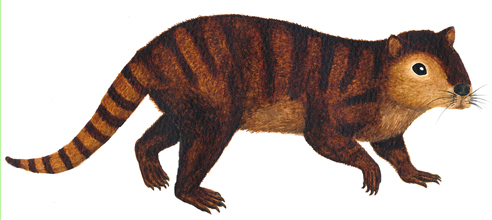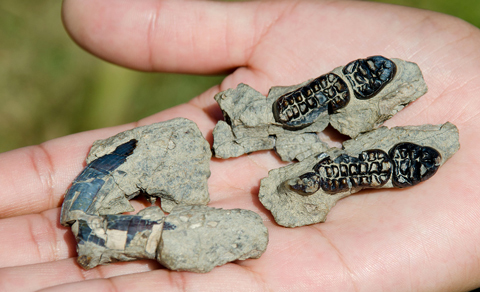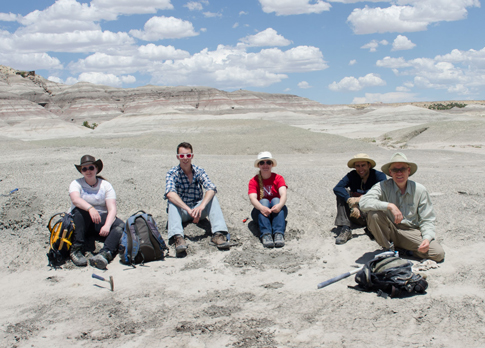Mammals Quick off the Mark after Dinosaur Extinction
Kimbetopsalis simmonsae – Shedding Light on Ancient Mammals after the Dinosaur Extinction
A newly described species of ancient mammal, one that existed around half a million years or so after the Cretaceous mass extinction event that saw the demise of the dinosaurs – the dinosaur extinction, is helping scientists to understand more about how the Mammalia Order radiated and diversified. The discovery from New Mexico (Nacimiento Formation), has been named Kimbetopsalis simmonsae, it seems that mammals were quick to take advantage of the vacuum left in terrestrial habitats by the dinosaurs.
Kimbetopsalis simmonsae
An Illustration of What Kimbetopsalis simmonsae Might Have Looked Like
Picture credit: Sarah Shelley
A Lucky Find for a Student
The fossils, which consist of the back of the jaws, part of the brain case and incisors from the front of the mouth were found during an exhibition to the San Juan Basin of New Mexico last year. Remarkably, the first evidence, the back of the jaws was found by University of Nebraska-Lincoln student Carissa Raymond, this was her first fossil hunting field trip.
The field team consisted of two other students, recruited by University of Nebraska-Lincoln palaeontologist Ross Secord and Steve Brusatte (University of Edinburgh). Thomas Williamson, curator of palaeontology at the New Mexico Museum of Natural History and Science, based in Albuquerque and a specialist in Late Cretaceous/Early Palaeocene fauna was also part of the group.
The paper describing this new species of prehistoric animal has just been published in the journal of the Linnean Society. K. simmonsae was a member of the multituberculates, a group of mammals that first evolved in the Jurassic. They thrived during the age of dinosaurs, but were mostly small and many described species are thought to have been nocturnal. Although, building up a more complete picture is difficult as most genera are known from only a few isolated teeth.
Beaver-sized Mammal
This beaver-sized mammal represents a relatively large example of this sub-order of mammals, the animal was named after the Kimbeto Wash area of the New Mexico Badlands, where the fossils were found.
Dr Stephen Brusatte, lead researcher on the study, explained:
“We realised pretty quickly that this was a totally new type of mammal that no-one has seen before, the other part of the name – psalis, means “cutting shears” and is in reference to the blade-like teeth [incisors].”
The Fossils of Kimbetopsalis simmonsae Note the Peculiar Cusps on the Molars and Premolars
Picture credit: Dr. Steve Brusatte University of Edinburgh
The Multituberculata Mammals
The multituberculate mammals are generally regarded as the earliest plant-eating mammals to have existed. The teeth of K. simmonsae are typical of this group, the long chisel-like front teeth and the back teeth, the chewing teeth, with their parallel rows of cusps. It is these back teeth with their distinctive cusps arranged in either two or three rows that gives the Multituberculata group their name. This discovery is the first new multituberculate to be found in the San Juan Basin in more than a century.
Members of the Field Team Pose for a Photograph
Picture credit: Thomas Williamson/Reuters
Fossils of another multituberculate from the genus Taeniolabis are known from this area, however, the newly described Kimbetopsalis simmonsae come from a geologically much older stratigraphic layer. Taeniolabis species represent some of the largest Multituberculata so far described, with some specimens estimated to about as big as an Alsatian dog and one species Taeniolabis taoensis possibly exceeding 100 kilogrammes in weight, although they were probably entirely herbivorous.
It has been proposed that Kimbetopsalis simmonsae may have been an ancestor of the Taeniolabis genus, part of a trend towards larger and larger mammals as the Mammalia radiated out and new species evolved to take advantage of the extinction of the dinosaurs. It seems that the mammals may have been quick off the mark to exploit the niches left after the dinosaur extinction.
Extinction of the Multituberculates
This type of mammal was soon destined to go the same way as the dinosaurs. By the Late Eocene, these creatures were becoming increasingly rare and by the Early Oligocene Epoch (around 32-30 million years ago), the Multituberculata were extinct. Why these mammals died out, remains an area of debate amongst palaeontologists. This group left no living descendants and a number of reasons why they became extinct have been proposed, one of the more plausible and popular explanations is increased competition from placental mammals, particularly rodents.
Rodents are the most diverse and most specious of all the types of mammal living today. Perhaps it was the evolution and rapid spread of the rodents that finally led to the demise of the Multituberculata, a group that had outlived the Dinosauria.
To read an earlier article that traces the origins of the Multituberculata: Tracing the Origins of the Multituberculates.
Dinosaur Extinction
Commenting on the significance of this fossil discovery, Dr Thomas Williamson said:
“Finding this new mammal was a pleasant surprise. It helps fill an important gap in the record of this group of mammals. It’s interesting that this odd, now extinct group, was among the few to survive the mass extinction and thrive in the aftermath. It may be because they were among the few mammals that were already well-suited to eating plants when the extinction came. This new species helps to show just how fast they were evolving to take advantage of conditions in the post-extinction world.”
Visit Everything Dinosaur’s website: Everything Dinosaur.




